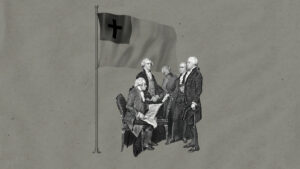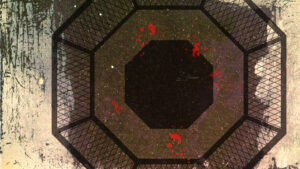What did Moses look like? How did Jesus dress? We’re never told. The Bible is an incredible literary work, but it’s often sparse on detail, leaving many descriptions of places, items, and people completely absent. So when Scripture does provide detail, it’s all the more important that we pay attention: the biblical authors may be hiding a gem in plain sight, if we have eyes to see it.
One such gem can be found in the use of a shade of red-purple cloth called argaman in different stories. The biblical authors highlight the reddish-purple color of certain fabric to make subtle claims about kingship, human rebellion, and God’s work to reestablish his control over creation once and for all. Ultimately, this red-purple theme is used to make a profound claim about Jesus.
Let’s walk through the biblical story of argaman, beginning in Exodus.
Clothing God and His Priests
The Hebrew word argaman denotes a deep, rich, wine-like shade of reddish-purple. It first appears in Exodus. YHWH has just delivered the Israelites through the sea from the hand of the Egyptians and brought them to Mount Sinai. Moses ascends the mountain, where he receives both instructions on how the Israelites should live in covenant relationship with YHWH, as well as elaborate plans for the tabernacle—a glorious tent, made of the finest materials, where God will dwell.
This red-purple theme is used to make a profound claim about Jesus.
Suddenly, the Bible gets very detailed. One of those details: God commands that the Israelites make the tabernacle’s curtains, veil, and screen for the doorway out of four things: (1) blue-purple cloth, (2) red-purple (argaman), (3) “scarlet worm” (a red twine), and (4) fine linen (Ex. 25:4, 26:1, 31, 36; 27:16).
This is significant. In our first mention of argaman, it’s being used to create God’s dwelling place. The argaman thus, in a sense, “clothes” God. Moreover, the tabernacle symbolizes Eden, the place where heaven and earth were once fully merged, which characterized the true “good life,” with God and humanity reconciled. The tabernacle, including the argaman out of which it was made, is a new Eden.
Argaman was used for something else too: the high priest’s clothing. God commands Moses to make the priestly ephod, the breastplate, and the hem of the priests’ robes from the same blue-purple, red-purple (argaman), red twine, and fine linen used for the tabernacle (Ex. 28:5–8, 13, 33). This too is significant.
The high priest fulfilled a dual representative role, representing God before Israel and Israel before God. He made sacrifices that atoned for the Israelites’ sins, and was the only person authorized to enter the Holy of Holies. In Exodus, argaman clothing is reserved for two individuals: (1) God himself and (2) God’s appointed representative. The Torah of Moses provides no sanction for argaman to go anywhere else.
Hijacked by Arrogant Rulers
Fast forward to the book of Judges. Israel possesses some of the promised land, but is rent apart by sin, idolatry, and oppression. Despite his people’s transgressions, God raises up “judges” to save them. In Judges 8:26, Gideon has just defeated the Midianites and is dividing the spoils of victory, which include the clothes of the Midianite kings: crescents, pendants, and argaman robes.
Argaman is depicted here as the vestment of royalty, which makes sense: in the Bible so far, only YHWH—the true King (Judg. 8:23)—and his chosen representative have worn argaman. But here, Gentile kings in rebellion against him have clothed themselves in it. By doing so, they’ve appropriated to themselves the clothes of the true King. In response to their hubris, YHWH sends his judge, Gideon, to cut them down.
Sadly the story doesn’t end there. After valiantly declaring that the true King is YHWH (Judg. 8:23), Gideon nonetheless takes the Midianites’ argaman robes and makes them into his (illegitimate) priestly ephod (Judg. 8:27). Gideon places this counterfeit ephod in his city—not the tabernacle—and “it became a snare to Gideon and to his family” (Judg. 8:27). He becomes like the kings of the nation he’s just defeated—creating for himself argaman clothes, counterfeit copies of items reserved for YHWH and his priest.
Gideon’s abuse of the argaman comes to characterize the rest of humanity, which, in the remainder of the Hebrew Bible, misuses argaman to create idols (Jer. 10:8) and even counterfeit Edens (Ezek. 27). The argaman, which should denote only YHWH, is used by perverted rulers to exalt themselves and create false paradises opposed to God’s will.
Stripped from the Proud, Given to the Lowly
Even in the Hebrew Bible, however, there are hints that God will not sit idly by forever as this occurs. In Esther 1, we are brought to an exquisite party in King Ahasuerus’s palace (Est. 1:4). The palace is decked out with the most beautiful trappings—including argaman and fine linen (Est. 1:6). Just like the others, King Ahasuerus has taken the materials of the tabernacle and created his own pretend Eden to exalt himself.
But the story doesn’t end here. Following the King’s party, Esther, an Israelite, is made queen, and she and her uncle Mordecai are used by God to save the Jewish people from the wicked Haman. In the process, Haman—who sought to exalt himself—is brought low and executed, while Mordecai is saved from execution and exalted to the king’s right hand and clothed in argaman (Est. 8:15). The book of Esther is a type of God’s action in history: the argaman is taken from the kings of the rebellious nations and given to God’s chosen representative, who is snatched from death and exalted.
Exalted by God
Daniel 5 is also instructive. A human king (Belshazzar) is once more exalting himself against God. A hand appears, writing on the wall, and the king is terrified. He calls for his pagan wise men to come, promising to clothe whoever can read the writing in “the red-purple” (argewan, the Aramaic cognate of argaman) and exalt him to rulership in the kingdom (Dan. 5:7). Here we see a twist on the story: Belshazzar exalts himself not by wearing the argaman, but by claiming power to clothe another human in the red-purple properly reserved for God.
When his pagan wise men fail, Belshazzar calls for Daniel and repeats his promise to clothe him with “the red-purple” if Daniel can interpret the writing (Dan. 5:11; 13–16). Daniel rightly refuses the gift (Dan. 5:17); it is, after all, not the king’s to give. Nonetheless, he faithfully interprets the writing on the wall. And despite his refusal, Daniel is clothed with the red-purple and exalted to rulership in the kingdom (Dan. 5:29).
Again, we see God’s workings: when a depraved king tries to exalt his own chosen person, God confounds the wisdom of his wise men, but exalts his faithful servant in whom his Spirit dwells (Dan. 5:11).
Crucified King
The significance of the red-purple imagery all culminates in Jesus. Fast forward to the Gospels, to Jesus’s unjust trial. He has been dragged before the Jewish council and Pilate. They wish to condemn him for exalting himself as the true King; blasphemy to the Jews and sedition to the Romans. The worldly powers condemn him to death on a cross, and the centurions are commanded to take him away. They strip him of his clothes, cover him with a robe and a crown of thorns, and mockingly pretend Jesus is king—only to strip him of his robe before leading him to Golgotha.
What is the color of this robe? There is a slight textual difference between the Gospels: Mark and John record that the robe is “purple” (Greek: porphyra; Mark 15:17; John 19:2). Matthew, however, describes the robe as “crimson” (Greek: kokkinos; Matt. 27:28). The difference in color is not a contradiction: the colors red and purple overlap, and a dark red robe could easily be described by one as purple and another as red.
But why highlight the color in the first place? Because the authors are expanding on the argaman theme of the Hebrew Bible. When the soldiers clothe Jesus with the red-purple, they unwittingly fulfill the Scriptures. Jesus is the true argaman-wearer. Jesus, clothed in red-purple, is the true tabernacle, the dwelling of God (John 1:14); he is the ultimate high priest (Heb. 4:14); and he is the true king, who receives his throne precisely through suffering and death—presaged by being clothed in red-purple (Rom. 1:4).
Jesus, clothed in red-purple, is the true tabernacle, the dwelling of God; he is the ultimate high priest; and he is the true king, who receives his throne precisely through suffering and death—presaged by his being clothed in red-purple.
The clothing of Jesus in red-purple is thus deeply ironic: though meant to mock him as a counterfeit king, in the end it makes the point that Jesus is the true God, the true priest, the true king. As with Daniel and Esther, Jesus’s clothing in the red-purple demonstrates that the kingdom is God’s and his plans will not be thwarted. While fallen leaders once more claim the power to bestow the argaman on whomever they choose, and then take it away, it is precisely through crucifixion and resurrection—presaged by his clothing in red-purple—that God makes Jesus King.
Warning and Hope
What does this mean for us? First, the Bible’s red-purple theme delivers a word of warning. It makes clear that we, as fallen humanity, will seek to create counterfeit paradises and exalt ourselves against God. We must take care that we remain humble and do not, in pursuit of our glory or vision of the good life, lift ourselves up in pride. For God humbles the proud.
Second, the red-purple is a word of hope. We can take confidence that God is the true King, and that his kingdom and people will be borne through suffering to exaltation, after the mold of Jesus. Even though the rulers of this world may exalt themselves and oppress the righteous, God will have the last word. Dressed in royal robes, we too will be exalted with Jesus in the last days to rule with him forever and ever.
Download your free Christmas playlist by TGC editor Brett McCracken!
 It’s that time of year, when the world falls in love—with Christmas music! If you’re ready to immerse yourself in the sounds of the season, we’ve got a brand-new playlist for you. The Gospel Coalition’s free 2025 Christmas playlist is full of joyful, festive, and nostalgic songs to help you celebrate the sweetness of this sacred season.
It’s that time of year, when the world falls in love—with Christmas music! If you’re ready to immerse yourself in the sounds of the season, we’ve got a brand-new playlist for you. The Gospel Coalition’s free 2025 Christmas playlist is full of joyful, festive, and nostalgic songs to help you celebrate the sweetness of this sacred season.
The 75 songs on this playlist are all recordings from at least 20 years ago—most of them from further back in the 1950s and 1960s. Each song has been thoughtfully selected by TGC Arts & Culture Editor Brett McCracken to cultivate a fun but meaningful mix of vintage Christmas vibes.
To start listening to this free resource, simply click below to receive your link to the private playlist on Spotify or Apple Music.





























